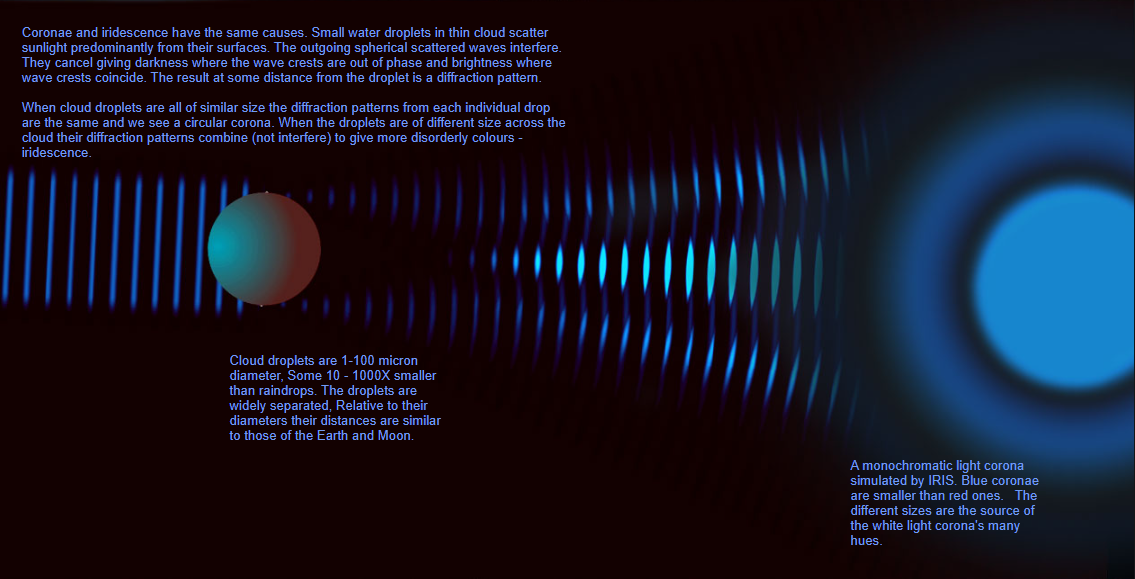OPOD - Corona & Iridescence
OPOD - Corona & Iridescence: A Mesmerizing Display of Atmospheric Optics
Have you ever witnessed a stunning display of colors in the sky, where vibrant hues merge and dance together? This captivating phenomenon is known as corona and iridescence, both of which are caused by the scattering of sunlight by tiny water droplets in thin clouds. In this article, we will delve into the intricacies of these optical phenomena and explore the factors that contribute to their mesmerizing appearances.
The Science Behind Coronae and Iridescence
Coronae and iridescence share a common origin. When sunlight encounters small water droplets in thin clouds, the majority of the light is scattered from the surfaces of these droplets. As the scattered waves propagate, they interfere with each other. This interference results in regions of darkness, where the wave crests are out of phase, and regions of brightness, where the wave crests coincide. The overall effect, observed at a certain distance from the droplets, is a diffraction pattern.
The Delicate Dance of Colors: Corona
When the cloud droplets are uniformly sized, the diffraction patterns from each individual droplet are identical, giving rise to a circular corona. Coronae typically appear as a series of concentric rings around the Sun or Moon. These rings exhibit a range of colors, with blue coronae being smaller in size compared to red ones. The variations in droplet size within the cloud contribute to the multitude of hues observed in a white light corona.
Unleashing Chaos: Iridescence
In contrast to coronae, iridescence emerges when cloud droplets vary in size across the cloud. When droplets of different sizes combine, their diffraction patterns no longer interfere constructively or destructively. Instead, they interact in a more disorderly manner, leading to the creation of iridescent colors. The result is a breathtaking display of shimmering, ever-changing hues that seem to dance across the sky.
Exploring the Microcosm of Cloud Droplets
To fully appreciate the scale of these optical phenomena, let's dive into the microscopic world of cloud droplets. These droplets typically range in diameter from 1 to 100 microns, making them 10 to 1000 times smaller than raindrops. Despite their diminutive size, the droplets are widely spaced relative to their own diameters, similar to the distances between the Earth and the Moon. It is within this intricate arrangement that the magic of coronae and iridescence unfolds.
A Glimpse into the Simulated World
To better understand the behavior of light in coronae, researchers utilize simulations. One such simulation, known as IRIS, allows scientists to recreate monochromatic light coronae. Through this simulation, it becomes evident that the size of the droplets plays a crucial role in determining the variety of hues observed in a white light corona. The diverse range of sizes among the droplets gives rise to the captivating array of colors that grace our skies.
Witnessing the Dance of Iridescence
The ethereal beauty of iridescence is often observed when thin clouds span across the sky, with droplets varying in size throughout the cloud. As sunlight interacts with these diverse droplets, the resulting diffraction patterns intertwine and create a kaleidoscope of colors. The ever-changing hues of iridescence can captivate onlookers, leaving them in awe of nature's ability to paint the sky with such delicate and vibrant brushstrokes.
In conclusion, corona and iridescence are two captivating atmospheric optics phenomena that arise from the scattering of sunlight by tiny water droplets in thin clouds. While coronae manifest as circular rings of colors around the Sun or Moon, iridescence showcases a more disorderly and ever-changing dance of hues. Understanding the science behind these phenomena allows us to appreciate the intricate beauty of our atmosphere and the enchanting displays it presents to us. So, the next time you find yourself gazing at the sky, keep an eye out for the mesmerizing coronae and iridescence that grace our world.

Corona & Iridescence
Ruthanne Fenske imaged this corona merging into more chaotic iridescence near Ely, Minnesota, USA. Thicker cloud prevented the corona's lower part from shining.
©Ruthanne Fenske, shown with permission.
Coronae and iridescence have the same causes. Small water droplets in thin cloud scatter sunlight predominantly from their surfaces. The outgoing spherical scattered waves interfere. They cancel giving darkness where the wave crests are out of phase and brightness where wave crests coincide. The result at some distance from the droplet is a diffraction pattern.
When cloud droplets are all of similar size the diffraction patterns from each individual drop are the same and we see a circular corona. When the droplets are of different size across the cloud their diffraction patterns combine (not interfere) to give more disorderly colours - iridescence.

Cloud droplets are 1-100 micron diameter, Some 10 - 1000X smaller than raindrops. The droplets are widely separated, Relative to their diameters their distances are similar to those of the Earth and Moon.
A monochromatic light corona simulated by IRIS. Blue coronae are smaller than red ones. The different sizes are the source of the white light corona's many hues.

Iridescence from droplets of varying size across thin cloud
Note: this article has been automatically converted from the old site and may not appear as intended. You can find the original article here.
Reference Atmospheric Optics
If you use any of the definitions, information, or data presented on Atmospheric Optics, please copy the link or reference below to properly credit us as the reference source. Thank you!
-
<a href="https://atoptics.co.uk/blog/opod-corona-iridescence-2/">OPOD - Corona & Iridescence</a>
-
"OPOD - Corona & Iridescence". Atmospheric Optics. Accessed on November 20, 2024. https://atoptics.co.uk/blog/opod-corona-iridescence-2/.
-
"OPOD - Corona & Iridescence". Atmospheric Optics, https://atoptics.co.uk/blog/opod-corona-iridescence-2/. Accessed 20 November, 2024
-
OPOD - Corona & Iridescence. Atmospheric Optics. Retrieved from https://atoptics.co.uk/blog/opod-corona-iridescence-2/.